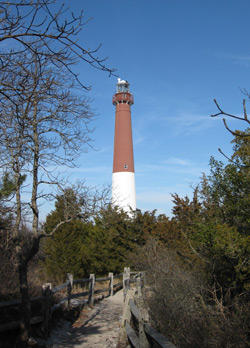 The northern end of Long Beach Island has a rich maritime history. Barnegat Inlet is a notoriously rough through fare that connects the Atlantic Ocean and Barnegat Bay and has been in use for many centuries. There are also shoals just off the local coast that have been responsible for wrecking many ships. Although shipping is still important today, during centuries past the ocean waters off of Barnegat Peninsula and Long Beach Island were part of an important shipping passage. Large boats would negotiate the New Jersey coast during trips to and from New York City. A lighthouse at Barnegat Inlet, and at other key points along the coastal route, proved to be vitally important for safety and navigation.
The northern end of Long Beach Island has a rich maritime history. Barnegat Inlet is a notoriously rough through fare that connects the Atlantic Ocean and Barnegat Bay and has been in use for many centuries. There are also shoals just off the local coast that have been responsible for wrecking many ships. Although shipping is still important today, during centuries past the ocean waters off of Barnegat Peninsula and Long Beach Island were part of an important shipping passage. Large boats would negotiate the New Jersey coast during trips to and from New York City. A lighthouse at Barnegat Inlet, and at other key points along the coastal route, proved to be vitally important for safety and navigation.
The first Barnegat Lighthouse was commissioned in 1834 by a Congressional appropriation of $6000. This first attempt at a lighthouse did not go well. The structure was completed the following year. It was 40 feet tall and had a light that was not very bright. There were also problems with erosion of the northern end of Long Beach Island. Half of the original 900 feet of land between the lighthouse and the ocean was gone within the first ten years.
Nearing an age of twenty years in 1854, the original light was finally replaced by a slighter stronger lens. Any improvements this offered were relatively short lived. The following year an inspection revealed that the now apparent inferior construction materials were deteriorating so badly that the lighthouse was crumbling. It was predicted the structure would fail in short order. The sea was also eroding more of the shoreline. In 1957 the light was moved to a temporary wooden structure and that same year the lighthouse collapsed into the sea.
Old Barney - the Second Barnegat Lighthouse
The inspector that predicted the demise of the original lighthouse was Lt. George Meade, the same man who would become a general and lead the Federal troops at the battle of Gettysburg. Before his more famous exploits, he both recommended building and designed the current Barnegat Lighthouse. The plans called for a larger lighthouse, a better light and a position that was 100 feet south of the original location. The cost was projected to be about $40,000.
The second, and present day, lighthouse was first lit on January 1, 1859. It stands 170 feet tall and was originally fitted with a first order Fresnel lens. This new lens allowed the light to be seen up to twenty miles away. The massive lens (8 feet in diameter and 15 feet high) was made at St. Gobain in France. It had 1,024 prisms and up until 1927 it was rotated using a clock like assembly that had to be hand wound every hour.
Obsolescence
In August 1927 the beacon from the lighthouse was largely replaced by the Barnegat Lightship. This was a lighted boat that was anchored eight miles offshore. The lighthouse still operated but the Fresnel lens was replaced and the light intensity reduced by 80%. The turning mechanism was also updated with an automated system. The lighthouse continued to operate until January 1944 when it was finally decommissioned. The structure did enjoy one last bit of use during this period when it was used as a lookout for German submarines.
The Barnegat Lightship was eventually replaced by a lighted buoy but it become obsolete and was removed from its station in 1965.
Relighting Old Barney
The Friends of Barnegat Lighthouse State Park committed to raising funds to relighting the lighthouse in 2008. A new Fresnel lens was purchased and the windows replaced with the $35,000 in funds that were donated. Interestingly the new lens cost the same as the original Fresnel lens - $15,000. The light complies with current maritime regulations and can be seen up to twenty miles away.
The lighthouse was first relighted on January 1, 2009, at 5:00 pm. This was the 150th anniversary of this second lighthouse's first lighting. Today the light is turned on from dusk till dawn.

